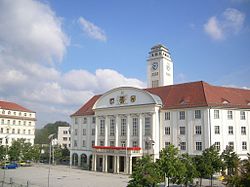Sonneberg
| Sonneberg | ||
|---|---|---|
 |
||
|
||
| Coordinates: 50°21′N 11°10′E / 50.350°N 11.167°ECoordinates: 50°21′N 11°10′E / 50.350°N 11.167°E | ||
| Country | Germany | |
| State | Thuringia | |
| District | Sonneberg | |
| Government | ||
| • Mayor | Dr.Heiko Voigt (CDU) | |
| Area | ||
| • Total | 84.86 km2 (32.76 sq mi) | |
| Population (2015-12-31) | ||
| • Total | 23,736 | |
| • Density | 280/km2 (720/sq mi) | |
| Time zone | CET/CEST (UTC+1/+2) | |
| Postal codes | 96501–96515 | |
| Dialling codes | 03675 | |
| Vehicle registration | SON | |
| Website | www.sonneberg.de | |
Sonneberg is a town in Thuringia, Germany, which is seat of the district Sonneberg. It has long been a centre of toy making and is still well known for this. It is the home of PIKO, a model railway manufacturer which became one of the few such enterprises in the Warsaw Pact countries and as such supplied model trains depicting railway stock of all the Soviet bloc countries. Sonneberg is home to the German Toy Museum ("Deutsches Spielzeugmuseum").
In divided post-war Germany, Sonneberg found itself 'unnaturally' cut off from its large neighbouring town of Coburg and could only face north economically. It was served by an unnaturally winding railway route and thus became somewhat isolated from the rest of East Germany. Its station is classified as a Hauptbahnhof ("central station") and is served by the Coburg–Sonneberg line.
The town Sonneberg consists of the following subdivisions:
Since 31 December 2013, when the former municipality Oberland am Rennsteig was merged into Sonneberg, the following villages also form part of Sonneberg: Haselbach, Eschenthal, Hasenthal, Hüttengrund and Spechtsbrunn.
1829-1981
1984-1999
2000-2006
2007-2013
from 2014
...
Wikipedia




